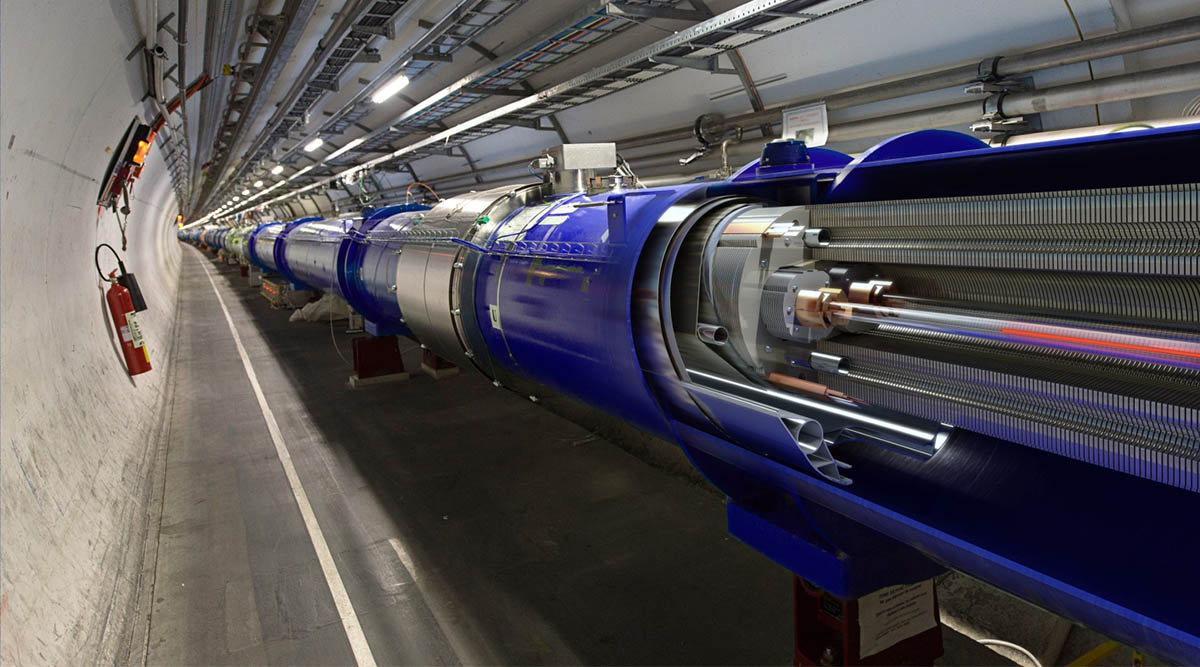The world’s largest particle accelerator, the Large Hadron Collider (LHC) is back in action since April for its third run after a three-year break for upgrades. Nearly ten years after scientists announced the discovery of the Higgs Boson, the particle accelerator is about to start smashing particles together at unprecedented energy levels. The European Organisation for Nuclear Research (CERN) announced that starting today (July 5), the LHC will run 24 hours a day for almost four years at a record energy level near 13.6 trillion electronvolts, according to AFP.
Its work will involve sending beams of protons, which are positively charged particles present in the nucleus of atoms, speeding towards each other at nearly the speed of light in the 27-kilometre ring of the LHC. Scientists will record and analyse the collisions of the particles in the two beams as part of a set of experiments, which will be used to study dark matter, dark energy and other mysteries of the universe.
As the LHC gears up to work at massive energy levels, here are 5 things that you need to know about it.
The largest and most complex machine ever built
LHC was built to study miniscule sub-atomic particles which are the smallest known units of matter and the building blocks of all things. But the collider itself is the largest and most complex machine ever built by man.
CERN built LHC between 1998 and 2008 in collaboration with over 10,000 scientists from hundreds of universities and laboratories. The machine lies in a more than 100-metres deep tunnel with a circumference of 27 kilometres.
1.6 billion collisions a second
At full power, trillions of protons will race around the LHC accelerator ring more than 11,245 times a second, since they travel at 99,999 per cent the speed of light. When the machine initially began operations, that meant it could engineer about 600 million collisions every second.
But this time, the proton beams will be narrowed to less than 10 microns, which is about the width of ten bacterial cells, to increase the rate of collisions, according to CERN’s head of accelerators and technology Mike Lamont, who spoke to AFP. With the thinner beam, scientists are aiming at delivering 1.6 billion collisions per second.
Many times hotter than the sun
The collision of the two beams generates temperatures more than 100,000 times hotter than the hottest part of the sun, which is the core. But that heat will be concentrated in a very small space. Even though such temperatures are being generated, the machine’s accelerator ring will be kept at a cool minus 271.3 degrees celsius using superfluid helium.
Massive amounts of data
CERN’s DATA Centre stores more than 30 petabytes of data per year from LHC experiments. To put that into context, that is enough data to fill 1.2 million Blu-ray discs or 250 years of HD video. The Data Centre has over 100 petabytes of this data permanently archived on tape.
Just the first chapter
LHC is the biggest and most complex machine in the world and it may have paved the way for some of the most important scientific discoveries in recent times, including the Higgs Boson. But CERN has plans for a future machine that will dwarf the LHC and this is called the Future Circular Collider.
In 2018, CERN released the proposal for a 100-kilometre-circumference Future Circular Collider. Compared to the 13.6 trillion electronvolts energy level of LHC, the Future Circular Collider will work at energy levels of up to 100 trillion electronvolts. The Future Circular Collider is an even bigger machine aimed at ensuring the seamless continuation of the world’s particle physics programme in the post-LHC era.
!function(f,b,e,v,n,t,s)
{if(f.fbq)return;n=f.fbq=function(){n.callMethod?
n.callMethod.apply(n,arguments):n.queue.push(arguments)};
if(!f._fbq)f._fbq=n;n.push=n;n.loaded=!0;n.version=’2.0′;
n.queue=[];t=b.createElement(e);t.async=!0;
t.src=v;s=b.getElementsByTagName(e)[0];
s.parentNode.insertBefore(t,s)}(window, document,’script’,
‘https://connect.facebook.net/en_US/fbevents.js’);
fbq(‘init’, ‘444470064056909’);
fbq(‘track’, ‘PageView’);







